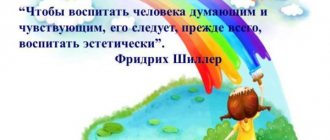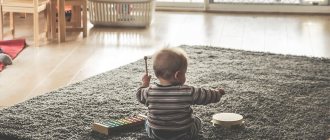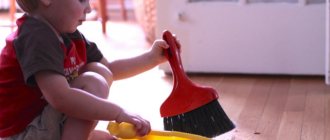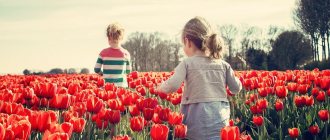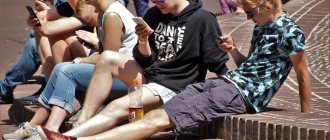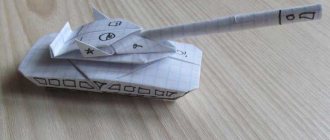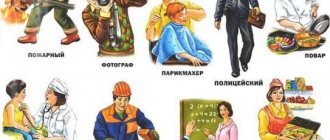Features of artistic and aesthetic development of children of primary preschool age
At the same time, the aesthetic properties of a person are not innate; they begin to develop from a very early age in the conditions of the social environment and active pedagogical guidance.
The development of young children should be considered as a preparatory stage for the aesthetic development of the surrounding world. It begins with the development of the distinctive sensitivity of the entire sensory apparatus and the emotional response to the perception of the most striking properties and qualities of objects (objects and phenomena). The child reacts joyfully only to some of the most striking qualities: to rhythmic movements, musical sounds, pure bright color tones, to the mother’s face, her smile, affectionate speech. Emotional responsiveness to pleasant fragments of individual phenomena manifests itself in an infant either in calmness after crying, or in violent motor excitement, in a reciprocal smile, in joyful laughter. Throughout the first year of life, children’s sensory-emotional sensitivity is actively improved. Gradually, in the second year of life, children's perception improves: the child perceives not only the properties of reality, but also certain means of aesthetic expression in some works of art. He has adequate reactions to contrasting means of expression in works of art: cheerful and sad melody, fast and slow tempo, loud and quiet sound of music, etc.
Imitation develops in various types of simple artistic and gaming activities, and a feeling of satisfaction appears not only from the process of activity, but also from achieving a certain result. The development of speech leads to the assimilation of the names of an increasing number of standard features, aesthetic qualities in the process of comparing them: beautiful - ugly, clean - dirty, big - small, cheerful - sad, red - green, etc. children are introduced to certain types of artistic activities (musical, visual, expressive words).
In early preschool age, further changes occur in the aesthetic development of the child. Increased sensitivity to works of art, to some elements of their artistic form, for example to rhythm, rhyme, color. Children's reactions to the content of the work as a whole become more varied. The child rejoices in the depiction of familiar objects that he recognized in works of art, but not yet in the image. The motive for its assessment is of an objective or everyday nature. Children of the younger group notice only individual signs of a phenomenon, use very laconic expressions, and sometimes very specific assessments. Children actively develop imitation in the simplest types of artistic and play activities, and new interests and needs are formed. In visual activities, children move from the simplest actions with a pencil or clay to depiction, recognition, naming, and figurative perception of the resulting forms. Associative images that arise in children based on color, spots, lines, shapes, under the influence of learning, acquire the intentional nature of the image. Children master the simplest skills not only in visual, but also in musical activities, allowing them to achieve imagery in what is depicted, independence and the initial manifestation of creative activity. All this indicates the presence of an aesthetic character in children’s artistic activity.
MAGAZINE Preschooler.RF
Integrated use of various means and methods of aesthetic education in the system of preschool educational organizationMigaleva Marina Vladimirovna, teacher of MBDOU DS No. 72 “Watercolor”, Stary Oskol, Belgorod region
The concept of aesthetic education is organically connected with the term aesthetics. Aesthetics (from the Greek aisthetiris - sentient, related to sensory perception) is the science of the most general laws of aesthetic, including artistic, human mastery of reality [11].
The history of aesthetics begins with Ancient Greece. In ancient Greek philosophers we find many interesting opinions about beauty and art. One of the first to try to define beauty was Pythagoras. In his judgments about aesthetics, he remained a mathematician and tried to calculate and measure beauty. Heraclitus sees harmony at the basis of beauty, but believes that beauty cannot be reduced to the base laws of numerical relations, as was the case with Pythagoras. Other researchers consider either character or social reality to be the main factor in aesthetic education.
Let's consider the concept of aesthetic education in the works of teachers
Author Definition
Aristotle Beauty is the property of objects, things, and phenomena themselves. He considers integrity, unity, proportionality, and correspondence of form and content mandatory for works of art.
- L. S. Vygotsky Aesthetic education depends on the specifics of age development and is completely determined by it.
- Yu. K. Babansky Aesthetic education is a process of joint activity of teachers and students, aimed at developing the aesthetic culture of preschoolers.
- V. N. Shatskaya Aesthetic education is the purposeful formation in a person of his aesthetic attitude to reality.
- A. Ilyinov Aesthetic education is the process of purposefully developing in a person the ability to understand and appreciate the beautiful and comic, to feel and experience the tragic, to create beauty in all spheres of life.
Author's opinion Aesthetic education is one of the areas of pedagogy, the main goal of which is to teach a person to understand and appreciate beauty.
There are many definitions of the concept of “aesthetic education”, but having considered only a few of them, it is already possible to identify the main provisions that speak about its essence.
Firstly, this is a process of targeted influence. Secondly, it is the formation of the ability to perceive and see beauty in art and life, and appreciate it. Thirdly, the task of aesthetic education is the formation of aesthetic tastes and ideals of the individual. Fourthly, the development of the ability for independent creativity and creation of beauty.
A variety of creative activities for children contribute to the development of their thinking and imagination, will, perseverance, organization, and discipline. The goal of aesthetic education was most successfully reflected by M. M. Rukavitsyn, who believes: “The ultimate goal (of aesthetic education) is a harmonious personality, a comprehensively developed person... educated, progressive, highly moral, with the ability to work, the desire to create, who understands the beauty of life and the beauty of art.” [18; 142 pp.]
Thus, having studied the many definitions of “aesthetic education”, one cannot but agree with the words of the Russian playwright A.P. Chekhov: “Everything in a person should be beautiful: face, clothes, soul, and thoughts . [20, 256 pp.]
According to scientists, nature is a powerful means of aesthetic education.
It is in it that you can see harmony - the basis of beauty: a variety of colors, shapes, sounds in their combination. Nature itself is a condition for the comprehensive education and development of a child. It becomes a means when an adult purposefully uses its “educational potential” and makes it visible to the child.
The teacher reveals the natural world to children and helps them see it. You just need to see this beauty for yourself and find words that are accessible to the heart of a child. Works of art about nature will provide him with invaluable help in this, which he must know well and skillfully use. In education using the means of nature, it is necessary not only a passive contemplative, but also an effective principle (to protect nature, to help it).
Social life, the work of people with whom the child constantly encounters, is also an important means of aesthetic education. The well-coordinated work of builders makes children want to create a good building, act together, and be attentive to each other. Excursions, when properly prepared and conducted, broaden the horizons of preschoolers, teach them to see, compare, generalize, which forms the basis for the development of creative imagination and abilities. [20]
A multifaceted and inexhaustible means of aesthetic education is art: fine art, music, literature, architecture, theater, cinema. The early introduction of children to real high art contributes to the emergence in the child’s soul of a truly aesthetic perception of reality. Each type of art reflects life in its own way and has its own special impact on the child’s mind and feelings.
From the first years of life, children are accompanied by oral folk art and children's literature. A fairy tale occupies a special place in their lives.
Another means of aesthetic education is the artistic activity of preschoolers, both organized by the teacher and independent. Fine art is necessary for a child. It gives him rich visual images.
In artistic activity, as a rule, there is a reproducing (reproductive) factor and a creative one. Both are necessary and interconnected - a child cannot create without learning to reproduce.
All of the above-mentioned means of aesthetic education - everyday life, nature, art, activity - are effective both on their own and in conjunction, but oversaturation is just as harmful to development as a lack of emotional impact. We must search and find the golden mean.
Having studied the most effective means of aesthetic education in a preschool educational organization, we will move on to studying the methods of aesthetic education.
A method is a way to achieve a goal, a way to solve problems [2].
Methods of aesthetic education are very diverse. They depend on many conditions: the volume and quality of artistic information, forms of organization and types of activities, and the age of the child. The level of training, skill and abilities of the teacher play a significant role. [19]
A child receives aesthetic information through many channels (social environment, objective world, natural phenomena, works of art). That is why the method of holistic perception of the plot of a painting, a fairy tale, or the musical and figurative construction of a piano piece is so important. To help the child listen to sounds, look at the colors and shapes of an object, the teacher directs his attention to more detailed perception and targeted observation. Based on how children receive aesthetic information (they get acquainted directly with a work of art, listening to a musical play, a song, a fairy tale, looking at paintings, or through a teacher who tells, explains, asks questions), methods of aesthetic education can be divided into visual and verbal. The performance of literary and musical works must be artistically expressive and emotional, otherwise the encounter with art will not have its impact. In the verbal method, it is also necessary to achieve vivid imagery so that children understand not only the content of a picture, poem, song or the meaning of the task, but also experience the mood corresponding to the mood of the characters [2].
Methods also change depending on the forms of organization of activities. During art classes, the teacher gives precise instructions, shows or invites children to find performance techniques themselves. An example would be learning poems or songs, which will require preliminary performance by an adult, a conversation about the artistic qualities that express the content and mood of the work, the use of visual aids, repeated performance of the text by children, and so on. In practice, methods are used to develop observation skills, independent actions, planning one’s activities and implementing plans. Depending on the age, level of preparedness, growth of individual needs and aspirations of the children, the methods become more complicated.
Pedagogical science and practice determine a number of the most effective methods that contribute to the formation of children’s aesthetic feelings, attitudes, judgments, evaluations, and practical actions: - the method of persuasion, aimed at developing aesthetic perception, appreciation, and initial manifestations of taste;
- training method, exercises in practical actions designed to transform the environment and develop skills of a culture of behavior
- method of problem situations that encourage creative and practical action
- a method of inducing empathy, emotionally positive responsiveness to the beautiful and a negative attitude towards the ugly in the world around us [2].
Consolidating acquired skills with practical actions allows you to bridge the gap between word and deed in the behavior of a child, who can say good words about the environment, but act contrary to them. Aesthetic experiences are always associated with ethical manifestations.
Thus, the means and methods of aesthetic education we are considering in a preschool educational organization help to awaken in children a sense of beauty, a desire to act according to their own, childish, but laws of beauty. At the present stage, these means and methods are effective and contribute to the formation of aesthetic feelings, attitudes, judgments, assessments, and practical actions in children.
In general, only a set of methods and means can provide a complete aesthetic education of a child.
List of used literature
- Azarov Yu.P. The art of education. M.: Education, 1985. -127 p.
- Alekseeva M.M., Yashina V.I. Speech development of a preschooler. M., 1998. -242 p.
- Amonashvili Sh.A. Reflections on humane pedagogy. M., 1996
- Bolotina L.R., Baranov S.P., Komarova T.S. Preschool pedagogy: Uch. allowance for higher education uch. head 2nd ed., rev. and additional M.: Academician. project, 2005. -240 p.
- Varkki N. A child in the world of creativity: Creative and aesthetic education of preschool children / N. Varkki // Preschool education. – 2003. – No. 6. — P.57-67.
- Borev Yu.B. Aesthetics. M.: Rus-Olympus: AST: Astrel, 2005. -829 p.
- Vygotsky L.S. Selected psychological studies. M., 1980. -384 p.
- Vygotsky L.S. Imagination and creativity in childhood. – M.: Pedagogy, 1991.
- Gavrilovets K.V., Kazimirskaya I.I. Moral and aesthetic education of preschool children: Book. for the teacher. 2nd ed., add. and processed Mn.: Nar. Asveta, 1985. –128 p.
- Dzhidaryan I.A. Aesthetic need / I.A. Dzhidarian. – M.: Nauka, 1986. -191 p.
- Doronova T.N. Development of children from 4 to 7 years old in theatrical activities // Child in kindergarten. – 2001. – No. 2.
- Zaporozhets I.D. Education of emotions and feelings in a preschooler. M., 1985. -186 p.
- Dramatization games // Emotional development of a preschooler / Ed. HELL. Koshelevoy. – M., 1983. – 76 p.
- Kazakova T.G. Develop creativity in preschoolers. A manual for children's educators. garden / T.G. Kazakova. - M.: Education, 1995.
- Krasny Yu. ABC of feelings: Program for the comprehensive aesthetic development of preschoolers / Yu. Krasny // Art at school. -2003. -No. 6. — p.17-29.
- Likhachev B.T. Methodological foundations of pedagogy / B.T. Likhachev. – Samara: Bakhrakh, 1998.
- Likhachev D.B. Theory of aesthetic education of preschool children.
- Melik-Pashaev A.A., Novlyanskaya Z.N. Steps to creativity / A.A. Melik-Pashaev, Z.N. Novlyanskaya. – St. Petersburg: Peter, 1997.
- Nadezhdin N.I. Works: In 2 volumes. T.1: Aesthetics / N.I. Nadezhdin / Ed. BEHIND. Kamensky. – St. Petersburg: Peter, 2000.
- Obukhova L.G. Psychology of childhood. M., 1992. -263 p.
| Next > |
Introduction
At the present stage of development of our state, against the backdrop of economic and political changes, the goal of the educational process is the comprehensive development of a preschool child.
Recently, attention has increased to the problems of the theory and practice of artistic and aesthetic education as the most important means of forming an attitude towards reality, a means of moral and mental education, that is, as a means of forming a comprehensively developed, spiritually rich personality.
Preschool age is the most important stage of personality development and education. This is the period of a child’s familiarization with the knowledge of the world around him, the period of his initial socialization. It is at this age that independent thinking is activated, children’s cognitive interest and curiosity develops.
In this regard, the education of preschoolers’ artistic taste, the formation of their creative skills, and their awareness of the sense of beauty is of particular relevance.
The purpose of the course work is to theoretically substantiate and experimentally test the possibility of forming the foundations of the artistic and aesthetic taste of older preschoolers through painting.
The object of the study is the process of artistic and aesthetic education of children of senior preschool age.
The subject is the implementation of the process of artistic and aesthetic education of children of senior preschool age.
Based on the purpose of the course work, we determine the following tasks:
- Study psychological and pedagogical literature on the problems of artistic and aesthetic education of preschool children;
- To substantiate the importance of paintings as a means of artistic and aesthetic education.
3. Experimentally test a series of classes and didactic games on
formation of the foundations of artistic and aesthetic taste in older children
preschool age through painting.
During the work, the following methods were used:
1. Theoretical analysis of psychological and pedagogical literature.
2. Observation.
3. Conversation.
4. Diagnostic tasks.
5. Quantitative and qualitative analysis of the results obtained.
As a hypothesis, we put forward the assumption that the formation of the foundations of the artistic and aesthetic taste of older preschoolers through painting will be effective if classes and didactic games are conducted that provide for the formation of the foundations of the aesthetic taste of older preschoolers through painting.
The methodological basis of the study was:
— conceptual ideas contained in the research of domestic and foreign teachers and psychologists about the nature and specific features of children's artistic creativity as an aesthetic phenomenon (D.V. Bakushinsky, E.I. Flerina, N.P. Sakulina);
— provisions of pedagogy and psychology on the meaning, relationship and interdependence of perception and creativity in children's visual activity (S.L. Rubinshtein, A.V. Zaporozhets, B.M. Teplov, etc.);
— the concept of understanding children's art as part of world artistic culture (B.P. Yusov, N.N. Fomina).
In the studies of B.M. Nemensky, N.A. Vetlugina, T.S. Komarova, R.M. Chumicheva, T.N. Doronova, E.A. Flerina and others have proven that communication with works of art has cognitive significance, helps the development and improvement of feelings, and actively contributes to the growth of the aesthetic consciousness of the individual.
The experimental study was carried out on the basis of the municipal budgetary institution of lyceum No. 67, kindergarten No. 172 “The Little Mermaid”, 20 children aged 5-6 years took part in it.
The course work consists of an introduction, 2 chapters, a conclusion, and a list of references.
